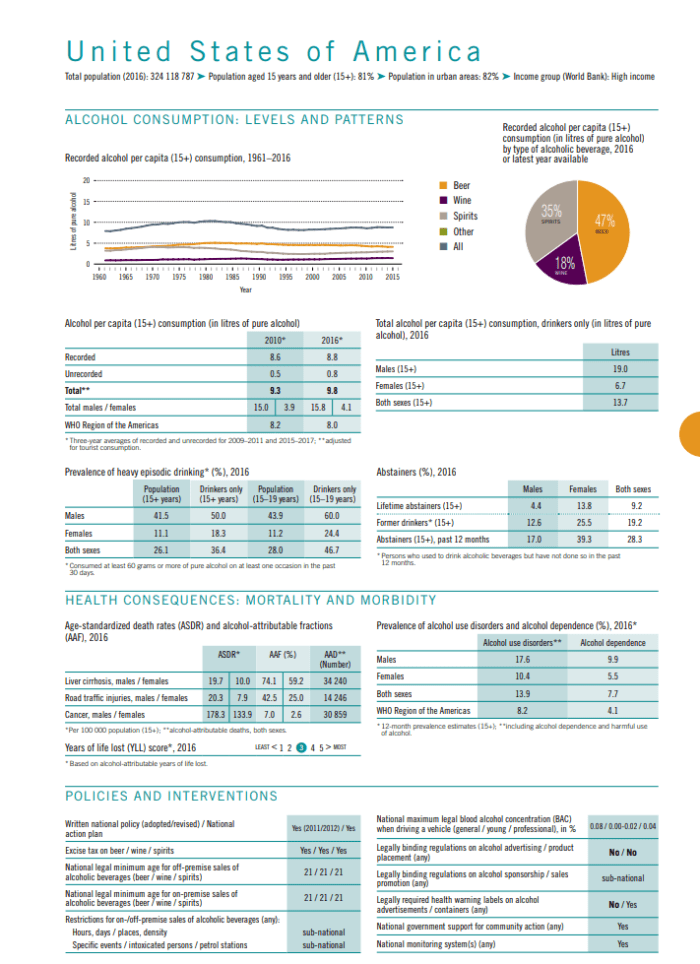USA: Alcohol-Related Deaths Rising
Two new studies have found that life expectancy in the USA is decreasing with rising alcohol-related deaths.
One study states, alcohol-related liver disease is partly to blame for the drop in life expectancy across the United States.
The researchers of the study published in the American Journal of Gastroenterology analyzed data from the Centers for Disease Control and Prevention (CDC). They found that U.S. deaths from alcohol-related liver disease (ALD) are at their highest levels since 1999 and have risen every year since 2006 in nearly every racial, ethnic and age group.
When analzing causes of death for people aged 25 and older in the two decades since 1997, they found, 2017 had the highest rates of death from ALD, at 13.1 per 100,000 deaths in men and 5.6 per 100,000 in women. That compares to 1999 ALD mortality rates of 10.6 per 100,000 in men and 3.3 per 100,000 in women.
The study also found people aged 55 to 64 years had the highest rate of deaths among all age groups, and rural areas showed higher mortality rates than urban ones.
Groups that were specifically affected by ALD were middle-aged adults, Native Americans and non-Hispanic whites.
Continued alcohol use and heavy episodic alcohol consumption are related to liver disease.
… the most important treatment is abstinence from alcohol,” said lead study author Dr. Andrew Moon of the University of North Carolina, as per Reuters.
Stopping alcohol will reverse fat in the liver, reduce the risk of future alcoholic hepatitis flares and improve liver function in patients with alcohol-related cirrhosis,” added Dr. Moon.
Life expectancy decreasing for 3 years in a row in the United States
Another group of researchers analyzed life expectancy in the United States from 1959 through 2017 and revealed that the general trend of life expectancy improvements over several decades, levelled off and has been on reverse since 2014.
According to the Washington Post, the report found:
- By age group, the highest relative jump in death rates from 2010 to 2017 — 29% — has been among people aged 25 to 34.
- The all-cause death rate — meaning deaths per 100,000 people — rose 6% from 2010 to 2017 among working-age people.
- The risk of death from drug overdoses increased 486% for midlife women between 1999 and 2017; the risk increased 351% for men in that same period.
Several reasons for this increased death rate are given by the researchers:
- Opioid epidemic,
- Drug addiction and,
- Obesity.
The researchers say the report shows an overall erosion of health in the United States.
IOGT International previously reported on the rise in “Deaths of Despair” in the United States. Dr. Anne Case, and Dr. Angus Deaton, find these deaths to be the main cause of the rise in death rates in the US since World War II in several groups of people.
Alcohol plays a prominent role in deaths of despair, contributing to overdoses, suicides, and liver disease, as well as to a broad range of other disease states that lead to mortality.
Alcohol burden in the United States
The World Health Organization (WHO) reports that the total per capita alcohol consumption in the United States is 9.8 litres which is above the regional average for the Americas. Alcohol use has risen in the country from 2010 to 2016. Binge alcohol use among youth between 15 to 19 years is high with 46.7% youth who use alcohol engaging in this harmful habit.
Alcohol harm is obvious in the country. Alcohol causes,
- 34,000+ deaths from liver cirrhosis,
- 14,000+ deaths from road traffic injury, and
- 30,500+ deaths from cancer.
Furthermore, 13.9% of the population suffer from alcohol use disorder and 7.7% are dependent on alcohol, both of these are above the WHO regional averages.
A recent study found that alcohol taxation in the U.S. does not even come close to covering the alcohol costs to the country and people.
Despite the obvious harm and costs to society the U.S. government is weakening alcohol control policy across the nation. For example, a majority of senators in the U.S. Congress is supporting a bill to make the massive excise tax break permanent for Big Alcohol.
The only alcohol policy-making that seems to be going on is in favor of the alcohol industry, promoting private profit interests. The public health and social justice dimension is absent from these attempts – despite overwhelming evidence of how alcohol is decimating families, communities and eroding economic productivity and sustainability.
It is imperative that the United States changes course now and resolves to effectively reduce the societal burden of alcohol harm.
